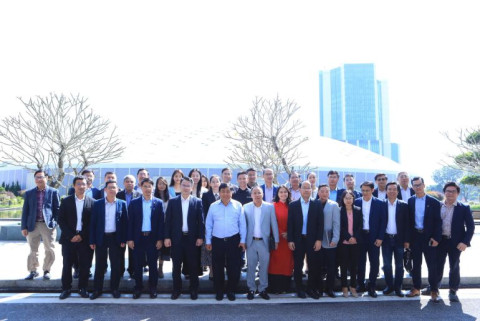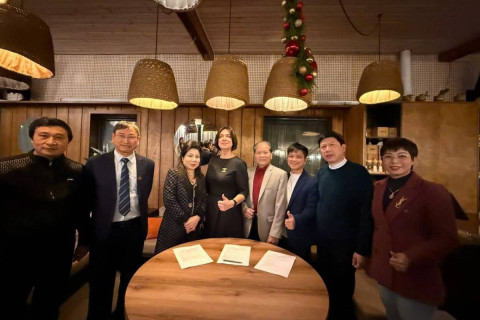Resort real estate: The path out of the "dark zone"
- 226
- Business
- 09:51 09/08/2024
DNHN - Resort real estate can overcome the "dark zone" by enhancing customer experience, maintaining and upgrading infrastructure, developing diverse amenities, and implementing effective marketing strategies.
The resort real estate segment, despite having great development potential, is facing significant challenges, referred to as the "dark zone." To overcome this difficult situation, the first step is to invest in improving customer experience, from services to amenities, to create memorable impressions.
Simultaneously, maintaining and upgrading infrastructure is necessary to maintain quality standards. Diversifying amenities and services also helps make the resort more attractive. Finally, building a comprehensive and effective marketing strategy will help reach potential customers from around the world. Only by implementing these strategies simultaneously can resort real estate rise from the "dark zone" and develop sustainably in the future.
In the 21st century, resort real estate has emerged as a globally dynamic development sector, attracting the attention of investors and tourists. However, this industry is not immune to challenges, especially when facing the "dark zone" – a period of difficulty and instability.

Currently, the resort real estate sector is facing difficulties due to several key factors. Economic and financial crises reduce demand and the ability to pay for resort real estate, leading to market stagnation. Natural disasters and climate change, such as storms, floods, and earthquakes, can devastate infrastructure, reducing the value of resorts. Additionally, changes in tourism trends and tourist demands can also decrease the attractiveness of resorts that previously drew much attention.
To help the resort real estate segment overcome difficult times, strategies need to focus on improving quality and competitiveness. Firstly, investing in customer experience is essential, providing superior services and amenities to meet diverse tourist needs. Next, regularly maintaining and upgrading infrastructure will ensure resorts maintain high quality and safety standards.
At the same time, developing a diverse system of amenities and services will create unique highlights, attracting customer interest. Finally, building a comprehensive and effective marketing strategy, using both digital and traditional media channels to reach customers from various markets, will help increase the presence and attractiveness of the resort on the global market.
To escape difficult situations, resorts need to focus on investing in customer experience. Understanding the needs and expectations of customers, thereby providing high-quality services and amenities, will create memorable travel experiences.
Moreover, maintaining and upgrading infrastructure is crucial to ensure the resort always maintains high-quality standards. Developing diverse amenities and services will also make the resort more attractive and draw more customers. Finally, building a comprehensive marketing strategy by using effective marketing channels will help reach and attract customers from various regions worldwide. Only by implementing these strategies simultaneously can the resort real estate industry rise and develop sustainably in the future.
In the first quarter of 2024, the real estate market recorded 9,970 tourism and resort products for sale, but more than 97% were inventory from old projects. Only five new projects provided 326 products, a decrease of 64% compared to the previous quarter and 60% compared to the same period in 2023. The number of successful transactions reached only 160, equivalent to 2% of the primary supply, showing that the resort segment is still facing difficulties.
According to experts, projects are still facing legal difficulties, with investment procedures being inconsistent and overlapping, leading to cautious investment decisions. The time to handle procedures such as investment policy approval and land clearance is prolonged, affecting the ability to create new supply.
Additionally, strict management of credit and bonds policies reduces the resources for project development, leading to delayed progress and affecting commitments to customers.
Nguyen An Phan
Related news
#real estate enterprises

Real estate capital faces risks from credit to bonds
Amid global economic turbulence, the real estate market faces significant risks from bank credit and corporate bonds.

Real estate businesses and macroeconomic challenges
The year 2024 marks a challenging period for real estate businesses, not only in Vietnam but also worldwide.

More than 1,000 new real estate businesses established in Ho Chi Minh City, transactions grow
In the first nine months of 2024, Ho Chi Minh City's real estate market witnessed the establishment of over 1,000 new businesses and recorded 1,600 property transactions, signaling a positive recovery trend.

What should real estate businesses do during a recession cycle?
When the real estate sector enters a recession cycle, businesses in the industry face significant challenges.

Dr. Tran Xuan Luong: Real estate businesses lacking resources will be eliminated from the game
Dr. Tran Xuan Luong believes that real estate businesses that lack resources and strategy will certainly struggle to survive in the current competitive environment.

Financial revenue - a bright spot for real estate enterprises
Financial revenue in the second quarter of 2024 has been an important bright spot, helping many real estate businesses maintain positive profits despite challenges from their core business activities, contributing to their financial stability.
Đọc thêm Business
From New Year messages of World Leaders to the “new rules” of the Global economy in 2026
At a pivotal moment of transition, New Year messages from capitals such as Hanoi, Beijing, Washington and Paris reflect distinct priorities and strategic visions.
Connecting Leaders, Shaping the Future: Strategic Leadership Planning Meeting – CorporateConnections Hanoi A
"Your network is your most powerful flowing asset. It generates value, multiplies opportunities, and accelerates your influence across borders."
Innovative ESG enterprise: Trạm Xe Việt startup proposes solutions to build a green mobility ecosystem
As Vietnam commits to achieving Net Zero by 2050 and tightens emissions standards, the transportation sector faces unprecedented pressure to transform.
Deputy Prime Minister Nguyễn Chí Dũng: “The country’s major challenges weigh heavily on my mind — and we must resolve them together.
On the morning of November 26, 2025, Deputy Prime Minister Nguyễn Chí Dũng chaired a high-level working session at the National Innovation Center (NIC) in Hòa Lạc.
Unitsky String Technologies signs cooperation agreements with three Vietnamese partners, opening a new direction for smart mobility and sustainable development
The signing ceremony took place in Minsk, Belarus, on November 28, 2025.
Before the D‑day to abolish flat‑rate tax: Fear of technology and costs leave small traders struggling to adapt
From 1 January 2026 the flat‑rate tax regime will be abolished. Small business households will be required to declare tax based on actual revenue. MISA supports the transition with technology to help micro‑merchants adapt smoothly and transparently.
Vietnamese enterprises at a crossroads: the impact of a potential US–China deal
As the world closely monitors every shift in US-China relations, emerging signals of a strategic agreement between the two global powers are raising hopes for global economic stability.
HDBank: Impressive profit growth, leading in profitability and advancing international integration
Ho Chi Minh City Development Joint Stock Commercial Bank (HDBank, stock code HDB) announced its consolidated profit before tax for the first 9 months of 2025 reached VND 14,803 billion, marking a 17% increase year-on-year (YoY).
TNI King Coffee sued for over VND 5 Billion in unpaid debts
On October 21, 2025, the People’s Court of District 10 in Ho Chi Minh City officially accepted a civil lawsuit concerning a commercial contract dispute between TKT Vietnam Plastic Packaging Joint Stock Company and TNI King Coffee Co., Ltd.
VINASME and Jeonnam Technopark Sign MOU on technology cooperation, human resource training, and trade promotion
On October 15, 2025, in Hanoi, VINASME and Jeonnam Technopark (Korea) signed an MOU to promote trade, advance technology transfer, and develop human resources between enterprises of both nations.











